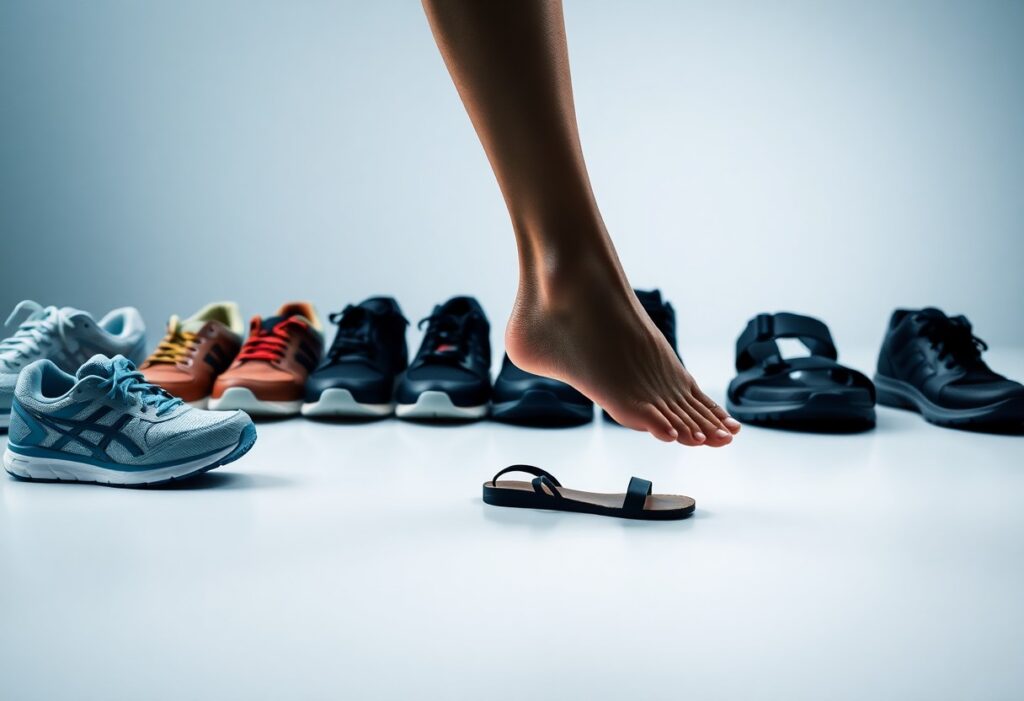
As you walk, your shoes can either help or harm your foot health. You may think that more cushioning and support are the answers to foot problems, but traditional shoes can actually do more harm than good. According to Dr. Alissa Kuizinas, a Massachusetts-based podiatrist, barefoot shoes or minimalistic shoes can be the key to stronger, healthier feet. By choosing shoes that allow your feet to function naturally, you can reduce the risk of foot issues and improve your overall foot health.
The Problem with Traditional Shoes
While traditional shoes may provide temporary relief from foot discomfort, they can also exacerbate existing problems and create new ones, according to Dr. Alissa Kuizinas, a Massachusetts-based podiatrist. She notes that the $133 billion shoe industry often prioritizes style and profit over foot health, leading to shoes that can immobilize and weaken your feet.
The shoe industry’s approach to foot problems
At the heart of the issue is the shoe industry’s approach to foot problems, which often involves adding more cushioning, support, and rigid structures to shoes, rather than addressing the root cause of the problem. This approach can lead to a dependence on shoes that can actually harm your foot health in the long run.
The limitations of traditional shoe design
Between the narrow toe boxes, stiff soles, and excessive cushioning, traditional shoe design can restrict natural foot movement and lead to weak and dysfunctional feet. Dr. Kuizinas notes that shoes should protect your feet from the elements, not immobilize them.
Shoe design should prioritize natural foot function and minimalist features, such as wide toe boxes, flat and flexible soles, and minimal cushioning. By choosing barefoot shoes or minimalistic shoes, you can strengthen your feet and improve your overall foot health. Dr. Kuizinas recommends a ‘as little shoe as possible’ approach to footwear, allowing your feet to function naturally and move freely.
The Importance of Foot Movement
Any shoe that restricts your foot movement can lead to foot problems and discomfort. You should consider how your shoes affect your foot health.
How shoes affect foot movement
To understand the impact of shoes on foot movement, you need to consider the design and features of your shoes. Traditional shoes with cushioning and support can actually hinder your foot movement, leading to weak and dysfunctional feet.
The benefits of natural foot movement
The benefits of natural foot movement are numerous, and strong feet are vital for overall foot health. You can achieve this by wearing minimalistic shoes or barefoot shoes that allow your feet to move naturally.
Movement is vital for building strong feet. When you wear shoes that restrict your foot movement, you can develop foot problems and discomfort. On the other hand, wearing minimalistic shoes or barefoot shoes can help you improve your foot health by allowing your feet to move naturally and build strength. By choosing the right shoes, you can reduce your risk of foot problems and improve your overall foot health.
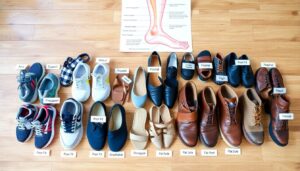
The Concept of Functional Shoes
It is important to understand the concept of functional shoes, which prioritize foot health and natural movement. Functional shoes are designed to allow your feet to function naturally, without excessive support or restriction.
Definition and characteristics of functional shoes
After researching and experimenting with different types of shoes, you will find that functional shoes have distinct characteristics, such as a wide toe box, flat and flexible soles, and minimal cushioning and support. These features enable your feet to move freely and naturally, promoting strong and capable feet.
Benefits of functional shoes for foot health
Benefits of functional shoes include improved foot strength, reduced risk of injury, and enhanced overall foot health. By wearing functional shoes, you allow your feet to function as they were designed to, which can lead to stronger feet and better balance.
Conceptually, functional shoes are designed to get out of the way of your feet, allowing them to move and bend naturally. This approach can lead to improved foot health and reduced risk of foot problems. By choosing functional shoes, such as barefoot shoes or minimalistic shoes, you can promote healthy foot function and reduce the risk of foot pain and injury. As you transition to functional shoes, you may need to be patient and build up your foot strength, but the benefits to your foot health will be worth it.
Key Features of Functional Shoes
For optimal foot health, you should look for shoes with certain features. Key features include:
- Wide toe box
- Flat and flexible soles
- Minimal cushion and support
Recognizing these features will help you choose shoes that promote healthy foot function.
Wide toe box and flexible soles
One of the most important features of functional shoes is a wide toe box that allows your toes to spread out naturally. This helps to prevent toe jamming and other issues that can lead to foot pain.
Minimal cushion and support
Besides the wide toe box, functional shoes should also have minimal cushion and support. This allows your feet to move naturally and strengthens the muscles in your feet, reducing the risk of foot problems.
Also, it’s vital to note that minimalistic shoes, such as barefoot shoes, can help to improve foot health by allowing your feet to function naturally. By wearing shoes with minimal cushion and support, you can strengthen the muscles in your feet and reduce the risk of injuries. This approach can also help to improve your overall foot health and reduce the risk of chronic pain. You should opt for shoes that allow your feet to move freely and naturally, without excessive cushioning or support.
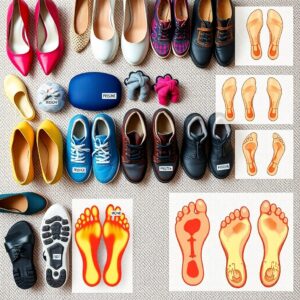
Transitioning to Functional Footwear
Now that you know the importance of functional footwear, it’s time to make the switch. Against the conventional wisdom of choosing shoes with more cushion and support, you should opt for minimalistic shoes or barefoot shoes that allow your feet to function naturally.
Tips for transitioning to functional shoes
Against all odds, you can start by incorporating functional shoes into your daily routine. Here are some tips:
-
- Start with short walks and gradually increase the distance
- Choose shoes with a wide toe box and flat soles
- Opt for minimal cushioning and support
The key is to allow your feet to adapt to the new shoes and strengthen your foot muscles.
The importance of patience and gradual progression
Importantly, transitioning to functional footwear requires patience and gradual progression. Shoes that are too minimalist can cause discomfort and pain if you’re not used to them. The key is to start slowly and allow your feet to adapt to the new shoes.
Shoes like barefoot shoes or minimalistic shoes can be beneficial for your foot health, but it’s important to introduce them gradually. Overuse or wrong sizing can lead to injuries or discomfort. The goal is to strengthen your foot muscles and improve your overall foot health, so be patient and don’t rush the process. The outcome will be worth it, as you’ll experience improved balance, reduced pain, and stronger feet.
Building Strong and Capable Feet
Despite the common practice of wearing shoes with excessive cushioning and support, you can build strong and capable feet by choosing the right footwear.
The role of foot strength in overall health
Alongside other factors, foot strength plays a significant role in your overall health, as it affects your balance, posture, and movement.
How functional shoes can help build strong feet
Functionally, shoes with a wide toe box, flat and flexible soles, and minimal cushioning can help build strong feet by allowing your feet to move naturally.
In fact, wearing functional shoes or barefoot shoes can help you develop stronger foot muscles and improve your overall foot health. By giving your feet the freedom to move and function naturally, you can reduce the risk of foot problems and improve your balance and stability. As you transition to minimalistic shoes, you’ll notice improvements in your walking form and overall well-being.
With this in mind, you can take control of your foot health by choosing shoes that work with your feet, not against them. You can opt for barefoot shoes or minimalistic shoes that allow your feet to function naturally, and build strength over time. By doing so, you’ll be able to enjoy activities with more stability and comfort, and give your feet the chance to grow strong and capable. You can start by looking for shoes with a wide toe box, flat and flexible soles, and minimal cushion and support, and be patient as you transition to a more natural way of walking.

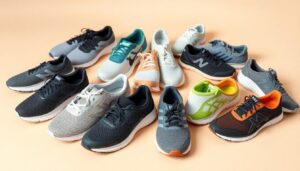

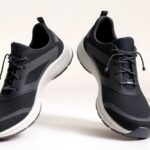





This topic really resonates with me. I’ve often found myself drawn to the cushioning and support of traditional shoes, especially as someone who spends long hours on my feet. However, after experiencing some foot discomfort, I started exploring minimalist footwear, and it genuinely changed my perspective on foot health.
Your insights into foot health and the implications of traditional footwear raise significant points that deserve further exploration. I have been reflecting on my own experiences with shoes over the years, and I can relate to the frustrations surrounding both comfort and functionality. Not long ago, I decided to transition to a more minimalistic style of shoe after realizing how frequently my traditional athletic shoes contributed to discomfort during my workouts. At the time, I was skeptical about the supposed benefits of barefoot shoes; I wondered how a shoe with less structure could possibly support my feet properly.
I find this topic on foot health and the impact of shoe choices really resonates with me, as I’ve been navigating my own journey with foot discomfort for quite some time. The idea that traditional shoes might do more harm than good is something I’ve mulled over after experiencing various issues myself, from lingering aches to more acute problems that prompted visits to the podiatrist.
This post really resonated with me! I’ve been on a journey towards minimalistic footwear myself and have noticed a huge improvement in my comfort and foot health. It’s fascinating how the shoe industry often overlooks our natural foot mechanics in favor of style. I remember when I switched to barefoot shoes; it felt strange at first, but gradually, my feet became stronger and more agile.
Your insights about the drawbacks of traditional shoes resonate deeply with me, especially in a society where style often overshadows functionality. As someone who has experienced foot discomfort, I can relate to the allure of cushioned shoes promising instant relief. However, it wasn’t until I switched to minimalistic footwear that I began to understand the importance of allowing our feet to move naturally.
It’s refreshing to hear someone share their journey with footwear choices. Many people chase that quick comfort from cushioned shoes without realizing how they can sometimes mask deeper issues instead of solving them. It’s interesting how switching to minimalistic footwear can feel almost revolutionary, isn’t it?
I find your insights on the traditional shoe industry and its impact on foot health to be both eye-opening and crucial in today’s world. It’s interesting to reflect on how often we prioritize aesthetics and trends over functionality, even when it comes to something as fundamental as our footwear. When I first switched to minimalist shoes after years of wearing conventional designs, I was surprised by how much more engaged my feet felt, and how this led to a more natural gait.
Ah, the age-old battle between style and comfort! I’ve always thought that shoes were like relationships: some are just too constrictive and leave you with blisters of regret. The idea that traditional shoes can do more harm than good really hit home for me. I once invested in a pair of trendy stilettos claiming “arch support,” but after one night out, my arches were screaming, and my feet were considering a rebellion!
This discussion on the impact of traditional footwear on foot health is quite illuminating. I’ve often noticed how my own feet feel restricted in standard shoes, especially after long periods of wearing them. It makes sense that shoes designed more for aesthetics than functionality could lead to issues like plantar fasciitis or overpronation.
I completely relate to your observations about how traditional footwear often compromises comfort for style. It’s interesting how we’ve created a culture where aesthetics frequently take precedence over foot health. I remember a few years ago, I made a similar shift in my own footwear choices after dealing with persistent heel pain. It wasn’t until I researched different foot types and understood how shoes can alter our biomechanics that I realized the impact of my choices.